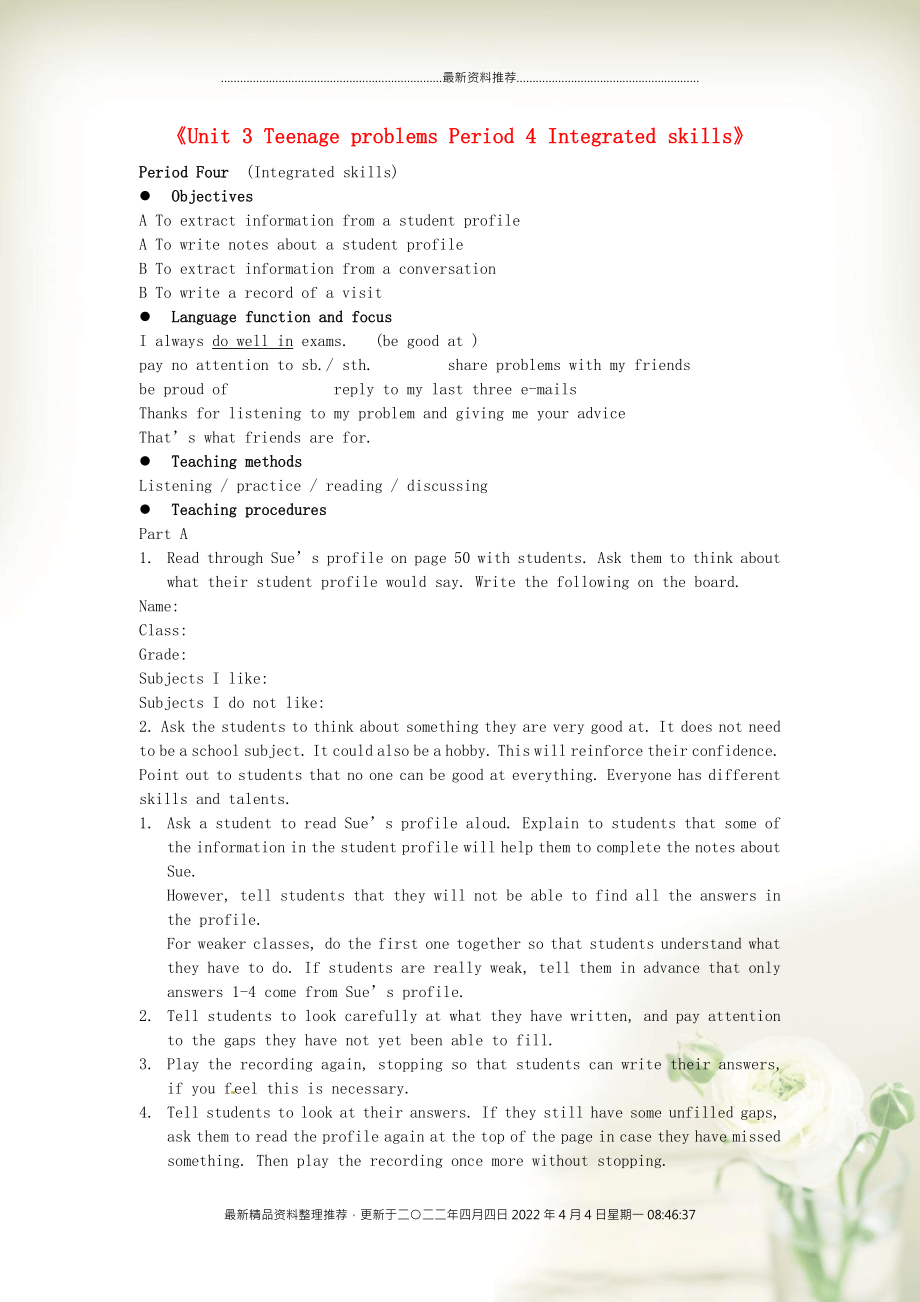《江蘇省東臺市唐洋鎮(zhèn)中學(xué)九年級英語上冊《Unit 3 Teenage problems Period 4 Integrated skills》教案 牛津版》由會員分享,可在線閱讀���,更多相關(guān)《江蘇省東臺市唐洋鎮(zhèn)中學(xué)九年級英語上冊《Unit 3 Teenage problems Period 4 Integrated skills》教案 牛津版(3頁珍藏版)》請?jiān)谘b配圖網(wǎng)上搜索���。
1、……………………………………………………………最新資料推薦…………………………………………………
《Unit 3 Teenage problems Period 4 Integrated skills》
Period Four (Integrated skills)
l Objectives
A To extract information from a student profile
A To write notes about a student profile
B To extract information from a conversation
B To wri
2���、te a record of a visit
l Language function and focus
I always do well in exams. (be good at )
pay no attention to sb./ sth. share problems with my friends
be proud of reply to my last three e-mails
Thanks for listening to my problem and giving me your advice
That’s what
3����、friends are for.
l Teaching methods
Listening / practice / reading / discussing
l Teaching procedures
Part A
1. Read through Sue’s profile on page 50 with students. Ask them to think about what their student profile would say. Write the following on the board.
Name:
Class:
Grade:
Subjects
4��、I like:
Subjects I do not like:
2. Ask the students to think about something they are very good at. It does not need to be a school subject. It could also be a hobby. This will reinforce their confidence. Point out to students that no one can be good at everything. Everyone has different skills an
5��、d talents.
1. Ask a student to read Sue’s profile aloud. Explain to students that some of the information in the student profile will help them to complete the notes about Sue.
However, tell students that they will not be able to find all the answers in the profile.
For weaker classes, do the fi
6��、rst one together so that students understand what they have to do. If students are really weak, tell them in advance that only answers 1-4 come from Sue’s profile.
2. Tell students to look carefully at what they have written, and pay attention to the gaps they have not yet been able to fill.
3. Pl
7���、ay the recording again, stopping so that students can write their answers, if you feel this is necessary.
4. Tell students to look at their answers. If they still have some unfilled gaps, ask them to read the profile again at the top of the page in case they have missed something. Then play the re
8��、cording once more without stopping.
5. Ask students to read one answer each. Check for mistakes and mispronunciation.
6. For weaker classes, it is useful to play the recording again once students have completed the exercise. This consolidates what students have learnt and gives them a sense of ach
9���、ievement.
7. Explain to students that they can use the profile and the note from page 50 to help them complete Part A3 on page 51. However, they should pay no attention to the syntax and make appropriate change of forms where necessary.
8. Divide the class into pairs. Each pair must work together
10、to come up with the correct answers. The first pair to get all of the answers correct wins.
9. Ask a person from each pair to read one sentence at a time. Encourage students to listen for mistakes and raise their hands when they have a question.
Part B
1. Review “worried”, “reply”, “e-card” and
11���、“advice”. For stronger classes, ask students to volunteer some definitions. For weaker classes, you can give the explanations to students.
2. Ask students to work in pairs. Tell them to read the conversation aloud, then change roles sn read the conversation again.
3. Check students’ conversation o
12����、f the passage. Ask them the following questions:
Who has a problem? (Millie)
What is her problem? (Her pen friend hasn’t replied to her e-mails.)
Does Amy agree that Millie’s pen friend doesn’t want to write to her any more? (No.)
Why does Amy think Millie’s pen friend hasn’t written? (She’)
Wh
13���、at advice does Amy give Millie? (Millie should send an e-card to her pen friend and let her know she misses her very much.)
Do you think Millie feels better after discussing her problem with Amy? (Yes.)
For weaker classes, students can give on-word answers. For stronger classes, ask students to re
14���、ply using full sentences.
4. Ask the students to use the conversation as a model to talk about their own problems and give advice. Ask them to practice their new conversations. Allow less able students to write down their conversations before practicing with a partner. Walk around the class and giv
15����、e help where necessary.
5. Ask a few pairs to read their conversations aloud to the whole class.
Homework: ( on exercise books)
完成下列句子��。1-3 必做4-6選做
1. Amy does well in sports. (否定句)
Amy ____________________________.
2. Her classmates often laugh at her. (被動(dòng)句)
She __________
16���、_________________.
3. Although Sue is a top student. She has some problems. (同意句)
Sue is a pop student, _________________________.
4. I don’t know how I can solve the problem.
I don’t know how _____________________________.
5. They felt tired after the hiking.
________________ they _______
17���、_____ after the hiking?
6 The teacher said to me “ Don’t use a dictionary when you meet new words.”
The teacher told me ________ to use a dictionary when I ___________ new words.
Design on Bb
Problems : homework
watch TV
hobby
18、 play computer games……..
I’ve got a problem. = I have a problem.
Why don’t you do sth.
Good idea. Thanks for doing sth.
My pleasure.
后記:本課主要掌握一個(gè)對話���,出現(xiàn)問題����,提出解決建議��。學(xué)生們在課上討論積極���,與教師配合得很好����。重點(diǎn)句型: Why don’t you do sth. = why not do sth. Thanks for doing sth. pay no attention to
最新精品資料整理推薦,更新于二〇二二年四月四日2022年4月4日星期一08:46:37
 江蘇省東臺市唐洋鎮(zhèn)中學(xué)九年級英語上冊《Unit 3 Teenage problems Period 4 Integrated skills》教案 牛津版
江蘇省東臺市唐洋鎮(zhèn)中學(xué)九年級英語上冊《Unit 3 Teenage problems Period 4 Integrated skills》教案 牛津版

